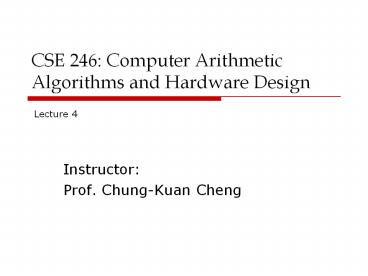CSE 246: Computer Arithmetic Algorithms and Hardware Design - PowerPoint PPT Presentation
Title:
CSE 246: Computer Arithmetic Algorithms and Hardware Design
Description:
CSE 246: Computer Arithmetic Algorithms and Hardware Design – PowerPoint PPT presentation
Number of Views:70
Avg rating:3.0/5.0
Title: CSE 246: Computer Arithmetic Algorithms and Hardware Design
1
CSE 246 Computer Arithmetic Algorithms and
Hardware Design
Lecture 4
- Instructor
- Prof. Chung-Kuan Cheng
2
HW 2 Due 1/27/05
- 11.2, 11.6, 11.7
- Design a number system different from the
conventional binary system. Inventing a new
number system would be ideal. Show that the
number system is better than the binary system in
certain aspect/s. Also, design/describe the basic
operations such as addition, subtraction, and
comparison.
3
Topics
- Adders
- Synchronous v.s. Asynchronous
- AND/OR gate v.s. Circuit
- Logic angle
- Graph angle (Prefix Adder)
4
Prefix Computation
- FSM example
- Given
- initial state S0A
- A sequence of inputs (0 0 1 1 1 0 1 0 1)
- Derive the sequence of outputs
PS NS12
A B
B B
C B
Compute Ns N1M0 N2M0 M0 N3M1 M0 M0 N4M1 M1
M0 M0
PS NS13
A C
B C
C C
Input Sequence 0 0 1 1
State table
PS Next State
X0 X1
A B A
B B C
C B A
PS NS14
A A
B A
C A
5
Graph Based Approach
- Consider the (g p) chain
- break the long paths
g3
p3
g2
p2
C4
g1
p1
C1
6
Graph Based Approach
- Generating g32 and p32
g3
g2
p3
p2
g1
p1
C4
g3
p3
g2
p2
C1
g32
p32
7
Graph Based Approach
- Generating g10 and p10
g3
g2
p3
p2
g1
p1
C4
g1
p1
cin
cin
g10
p10
8
Graph Based Approach
- Generating g30 and p30
g32
p32
g10
g30
p10
p30
9
Boolean Approach
- g4 p4 ( g3 p3 ( g2 p2 ( g1 p1 ( g0 p0
cin ) ) ) ) - g4 , p4 g3 , p3 g2 , p2 g1 , p1 g0
, p0 cin - g4p4g3 , p4p3 g2p2g1 , p2p1 g0
, p0cin - g4p4g3p4p3(g2p2g1) , p4p3p2p1 g0 ,
p0cin - g4p4g3p4p3(g2p2g1)(p4p3p2p1)g0 , (p4p3p2p1)
p0cin
10
Prefix Adder
- Given
- n inputs (gi, pi)
- An operation o
- Compute
- yi (gi, pi) o o (g1, p1) ( 1 lt i lt n)
- Associativity
- (A o B) o C A o ( B o C)
a, i1 aibi , otherwise 1, i1 ai xor bi ,
otherwise
gi pi
- (g, p) o (g, p) (g, p)
- gg pg
- ppp
11
Prefix Adder Graph Representation
ai bi
- Example
- Ripple Carry Adder
(gi , pi)
x y
xoy xoy
12
Prefix Adders Conditional Sum Adder
8 7 6 5 4 3 2 1
13
Prefix Adders Conditional Sum Adder
8 7 6 5 4 3 2 1
- alphabetical tree
- Binary tree
- Edges do not cross
- For output yi, there is an alphabetical tree
covering inputs (xi, xi-1, , x1)
14
Prefix Adders Conditional Sum Adder
8 7 6 5 4 3 2 1
- The nodes in this tree can be reduced to
- (g, p) o c gpc
- From input x1, there is a tree covering all
outputs (yi, yi-1, , y1)
15
Prefix Adders size and depth
- Objective
- Minimize of nodes, sc(n).
- Minimize depth, dc(n)
- Ripple Carry Adder
- sc(8) 7
- dc(8) 7
- total 14
- Conditional Sum Adder
- sc(8) 12
- dc(8) 3
- total 15
16
Prefix Adders size and depth
- Theoremsc(n)dnc(n) gt sc(n)dnc(n) gt 2n-2
- dnc(n) means the depth of the last output
- Proof
- Alphabetical tree of yn contains n-1 internal
nodes. - For each column where the prefix is not ready,
at lease one extra node is needed, therefore we
need at least n-(dnc(n) 1) extra nodes - sc(n) gtn-1(n(dnc(n)1))2n-2-dnc(n)
- sc(n) dnc(n) gt 2n-2
17
Prefix Adders Brent Kung Adder
15 14 13 12 11 10 9 8 7 6 5 4 3
2 1 0
- sc(16) 26
- dc(16) 6
- total 32
18
Carry Skip Adder
a3,0 b3,0
a7,4 b7,4
a11,8 b11,8
cin
c4
c8
c12
A0
A1
A2
p3,0
p7,4
p11,8
x
0 1
0 1
0 1
c12
c4
c8
- If p3,0p3p2p1p0 1, then x cin
19
Carry Propagation Paths
- A2 lt- MUX lt- MUX lt- cin
- A2 lt- MUX lt- A1
- A2 lt- MUX lt- MUX lt- A0
- c12 lt- MUX lt- A2
- c12 lt- MUX lt- MUX lt- A1
- c12 lt- MUX lt- MUX lt- MUX lt- A0
- c12 lt- MUX lt- MUX lt- MUX lt- MUX lt- cin
20
False Path
- A1 lt- MUX lt- A0 lt- cin is a false path
- If carry is from cin, then block must have
p3p2p1p0 1 - Since p3,0 1, g3,0 must be 0
- The carry is not generated from A0
- The carry needs not to propagate via A0, it will
go from the MUX
21
Label Algorithm
- Problem
- Given a digraph, a set of false paths
- Derive the longest path of the graph
- Algorithm
- Color the edges on each false path a label
- The length of the walk of the same labels are
accumulated - Otherwise, change to no label































